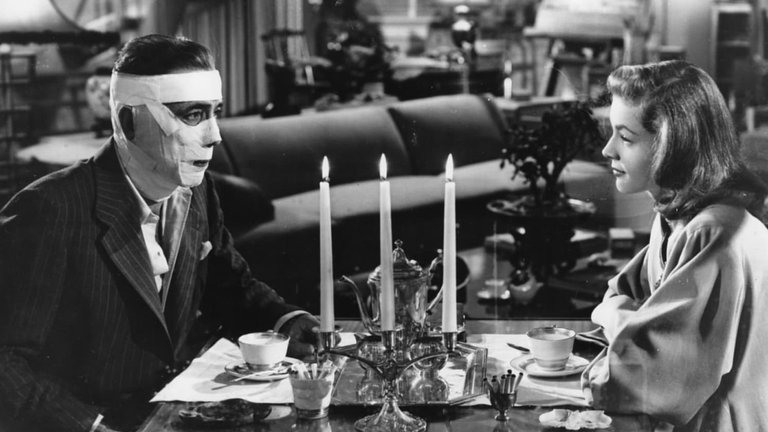Film Review: Dark Passage (1947)

If a title of film noir icon should be given to a single actor, the most suitable candidate is Humphrey Bogart, the most iconic of all actors of 1940s Hollywood. The most “noirish” and of the darker films he has appeared is Dark Passage, 1947 crime drama written and directed by Delmer Daves, also known as one of the more unusual and more innovative examples of the genre.
The film is based on the eponymous 1946 novel by David Goodis that would, decades later, become subject plagiarism suit filed against producers of popular TV series The Fugitive which had similar premise. The plot is set in San Francisco and begins when Vincent Parry (played by Bogart) escapes from San Quentin Prison, where he was serving sentence for murder of his wife. Parry is actually innocent and was convicted on the testimony of Madge Rapf (played by Agnes Moorehead), former female friend vengeful of rejecting her own romantic advances. Parry during his escape receives unexpected help from Irene Jansen (played by Lauren Bacall), socialite and aspiring painter who always believed in his innocence. She gives him temporary shelter in her home from where he, through guidance of sympathetic taxi driver Sam (played by Tom D’Andrea) goes to “problematic” part of city and hires services of Dr. Walter Coley (played by Houseley Stevenson), disgraced physician who perform plastic surgery on him. Parry has originally planned to recuperate in the home of his best friend George Fellsinger (played by Rory Mallinson), but instead he finds George murdered and now has little option but to ask Irene again for help. While she nurses him and gradually falls in love, Parry has to decide whether to leave country or try to finding the real killer and prove his innocence.
David Goodis liked to spend time frequenting seedy bars and hang out with people from the bottom of society, and this was reflected in his novels (many of which would later be adapted for screen in Hollywood and France) where the plot took perspective of outcasts and losers. Dark Passage features one such protagonist, a man who starts as escaped convict and whose attempt to prove innocence and return to normal society seems doomed from the start and leads from one disaster to another. The only thing that keeps Parry from returning behind bars and likely encounter with gas chamber is his own propensity of violence and occasional assistance from characters like Sam and Dr. Coley who, being marginalised outcasts in their own way, see him as kindred spirit. Social commentary, however, didn’t cause much interest among the public nor with the critics. Instead, Dark Passage is best known for unusual technique of showing plot in the first half almost exclusively through protagonist’s point-of-view shots. The procedure, pioneered one year earlier in another film noir Lady in the Lake, works through brilliant cinematography of Sidney Hickox and steady direction of Delmer Daves. It becomes “gimmicky” at the moment when it is abandoned after Parry goes through surgical procedure and Bogart, who was highest paid Hollywood actor at the time, finally shows up first in bandages, then with his proper face.
The major problem for Dark Passage is Daves’ script that relies too much on convenient plot coincidences. Parry during his escape first encounters man who is later revealed to be opportunistic career criminal; the only justification for his presence is through great performance by Clifton Young, youthful character actor whose life and career and life were four years later cut short by tragic accident. Parry also finds that Irene is conveniently part of the same social circles he had belonged to before his incarceration. Those flaws, however, have compensated with great acting, although Bogart, who obviously enjoyed working with his glamorous and loving wife Lauren Bacall, doesn’t make such strong impression as with his most iconic roles. He is much overshadowed by supporting players that involve Agnes Moorehead as one of the vilest of female villains of Classic Hollywood and Tom D’Andrea as protagonist’s unlikely saviour. Even better than the cast is San Francisco with its iconic locations, which include Malloch Building, piece of Art Deco architecture that served as Irene’s apartment and which is one of minor city landmarks. Daves by end brings plot twists and violence that was quite shocking for 1940s standards, but ends film with somewhat unconventional happy ending that might restore audience’s faith in humanity. Dark Passage, although far from being among top classics, can be recommended to fans of Bogart and film noir.
RATING: 7/10 (+++)
_
Blog in Croatian https://draxblog.com
Blog in English https://draxreview.wordpress.com/
InLeo blog https://inleo.io/@drax.leo
InLeo: https://inleo.io/signup?referral=drax.leo
Unstoppable Domains: https://unstoppabledomains.com/?ref=3fc23fc42c1b417
Hiveonboard: https://hiveonboard.com?ref=drax y
Bitcoin Lightning HIVE donations: https://v4v.app/v1/lnurlp/qrcode/drax
Rising Star game: https://www.risingstargame.com?referrer=drax
1Inch: https://1inch.exchange/#/r/0x83823d8CCB74F828148258BB4457642124b1328e
BTC donations: 1EWxiMiP6iiG9rger3NuUSd6HByaxQWafG
ETH donations: 0xB305F144323b99e6f8b1d66f5D7DE78B498C32A7
Posted using CineTV
Congratulations @drax! You have completed the following achievement on the Hive blockchain And have been rewarded with New badge(s)
Your next target is to reach 420000 upvotes.
You can view your badges on your board and compare yourself to others in the Ranking
If you no longer want to receive notifications, reply to this comment with the word
STOP